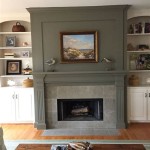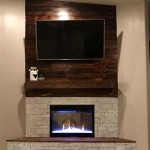Best Fireplace Inserts: A Comprehensive Guide
Fireplace inserts offer a practical and efficient way to transform an existing open fireplace into a powerful and controllable heat source. Unlike traditional fireplaces, which can lose a significant amount of heat up the chimney, inserts are designed to capture and radiate warmth into the room, improving energy efficiency and reducing heating costs. This article provides a detailed overview of fireplace inserts, exploring different types, key considerations for choosing the right model, and the advantages they offer over traditional fireplaces.
A fireplace insert is essentially a closed combustion system designed to fit within the existing firebox of a traditional fireplace. This unit is typically made of cast iron or steel and features a glass door that allows users to view the flames while maintaining a controlled burning environment. The insert is connected to the chimney with a flue liner, ensuring proper venting of combustion gases. By sealing off the open fireplace, inserts minimize heat loss and maximize the amount of heat radiated into the living space.
Types of Fireplace Inserts
Fireplace inserts are primarily categorized by their fuel type: wood, gas, and electric. Each type offers distinct advantages and disadvantages in terms of heating efficiency, cost, maintenance, and environmental impact.
Wood Fireplace Inserts: These inserts burn wood as fuel, providing a traditional and aesthetically pleasing heating experience. They are often favored for their high heat output and the ambiance they create. However, wood-burning inserts require a consistent supply of wood, which must be properly seasoned and stored. They also necessitate regular cleaning and maintenance, including ash removal and chimney sweeping to prevent creosote buildup, which can pose a fire hazard. Modern wood inserts often incorporate advanced combustion technologies, such as catalytic converters or non-catalytic designs, to improve efficiency and reduce emissions. These technologies help to burn off more of the combustible gases and particulate matter produced during combustion, resulting in cleaner burning and higher heat output.
Gas Fireplace Inserts: Gas inserts utilize natural gas or propane as fuel, offering a convenient and user-friendly heating option. They can be easily ignited and controlled with a thermostat or remote control, providing consistent and adjustable heat. Gas inserts require a gas line connection and professional installation to ensure safe and efficient operation. They produce less ash and require less maintenance compared to wood-burning inserts. Gas inserts are available in a variety of styles and designs, including models that mimic the appearance of a traditional wood-burning fireplace. Venting options for gas inserts include direct vent, which uses a sealed system to draw combustion air from outside and exhaust gases directly outdoors, and vent-free, which do not require an external vent but may be subject to local regulations due to potential indoor air quality concerns.
Electric Fireplace Inserts: Electric inserts are the simplest type to install and operate, requiring only a standard electrical outlet. They use electric heating elements to generate heat and often feature realistic flame effects. While electric inserts are generally less efficient than wood or gas inserts in terms of heat output per energy unit consumed, they are a convenient and cost-effective option for supplemental heating in smaller spaces. Electric inserts are also a good choice for homes where venting is not possible or practical. They are available in a wide range of styles and designs, and some models include features such as adjustable flame brightness, thermostat controls, and built-in timers.
Key Considerations When Choosing a Fireplace Insert
Selecting the right fireplace insert requires careful consideration of several factors, including the size of the space to be heated, the desired fuel type, efficiency ratings, venting requirements, and aesthetic preferences.
Heating Capacity: The heating capacity of a fireplace insert is typically measured in British Thermal Units (BTUs). The appropriate BTU rating will depend on the size of the room or area to be heated. A larger space will require a higher BTU rating to effectively maintain a comfortable temperature. It is important to consult with a qualified professional to determine the optimal BTU rating for your specific needs. Factors such as insulation levels, climate, and the number of windows and doors in the room can all influence the heating requirements.
Efficiency Ratings: The efficiency of a fireplace insert is a measure of how effectively it converts fuel into usable heat. Higher efficiency ratings indicate that a greater percentage of the fuel's energy is being used to heat the space, resulting in lower heating costs. Wood-burning inserts are often rated using a Lower Heating Value (LHV) efficiency, while gas inserts are typically rated using an Annual Fuel Utilization Efficiency (AFUE). Electric inserts are generally considered to be 100% efficient, as all of the electricity consumed is converted into heat. However, the overall cost of heating with electricity may be higher than with wood or gas, depending on local energy prices.
Venting Requirements: The venting requirements for a fireplace insert will vary depending on the fuel type. Wood-burning inserts require a properly sized and installed flue liner to safely vent combustion gases. Gas inserts can use either direct vent or vent-free systems, with direct vent systems being the more common and generally safer option. Electric inserts do not require any venting. It is crucial to comply with all local building codes and regulations regarding venting to ensure safe and proper operation.
Aesthetic Preferences: Fireplace inserts are available in a wide variety of styles and designs to complement different architectural styles and interior décor. Options range from traditional cast iron models to sleek and modern designs with clean lines and contemporary finishes. Consider the overall aesthetic of your home and choose an insert that will enhance the visual appeal of your living space. Some inserts also offer customizable features such as different door styles, decorative surrounds, and log sets.
Advantages of Fireplace Inserts Over Traditional Fireplaces
Fireplace inserts offer several significant advantages over traditional open fireplaces, primarily in terms of energy efficiency, heating performance, and safety.
Improved Energy Efficiency: Traditional fireplaces are notoriously inefficient, with much of the heat generated escaping up the chimney. Fireplace inserts, on the other hand, are designed to capture and radiate heat into the room, significantly improving energy efficiency. By sealing off the open fireplace and using a closed combustion system, inserts minimize heat loss and maximize the amount of heat that is used to warm the living space. This can result in substantial savings on heating costs over time.
Enhanced Heating Performance: Fireplace inserts provide more consistent and controllable heat compared to traditional fireplaces. They can be easily adjusted to maintain a desired temperature and often feature thermostat controls or remote controls for added convenience. The closed combustion system also allows for more complete burning of the fuel, resulting in higher heat output and lower emissions. This makes inserts a more effective and reliable heating source, particularly in colder climates.
Increased Safety: Fireplace inserts improve safety by containing the fire within a closed combustion chamber. This reduces the risk of sparks and embers escaping into the room, preventing potential fire hazards. The glass door also provides a barrier between the fire and the living space, protecting occupants from burns. Furthermore, the sealed system ensures proper venting of combustion gases, minimizing the risk of carbon monoxide poisoning. It is essential to have a carbon monoxide detector installed in your home, regardless of the type of heating system you use, to provide an additional layer of safety.

Best Fireplace Inserts In 2024

Fireplace Inserts Gas Wood Pellet Electric Best Fire Hearth Patio

Fireplace Insert Guide Fireplaces Direct Learning Center

9 Best Electric Fireplace Inserts Of 2024 Tested And Reviewed

Which Fireplace Inserts Are Best We Love Fire

Best Wood Fireplace Inserts Fireplaces Direct Learning Center

Comparing Fireplace Inserts What S Best For You Forge Flame

Best Fireplace Inserts In 2024

9 Best Electric Fireplace Inserts Of 2024 Tested And Reviewed

9 Best Electric Fireplace Inserts Of 2024 Tested And Reviewed
Related Posts








